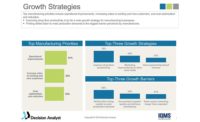Enterprising Resource Planning (ERP) software is an integral part of most business and manufacturing environments. It acts as the operational and transactional system of record for the business. Some ERP software is solely used for accounting while other ERP systems handle all of the sales, purchasing, shipping, production, and accounting processes. This software is the nucleus that ties these and other areas of the company together in a controlled, user friendly, repeatable process. Many ERP software experts contend that a good ERP system can handle 85-95% of an organization’s computer needs. When deciding what system is best for your organization keep in mind the new trends in technology, mobility, adaptability, lean manufacturing and collaboration.
Critical Business Issues
ERP systems can range from one that is operated by only a few people at a single location to a system that is operated by thousands of people at several sites around the world. First, determine the critical business issues of your market. According to Jay Deakins, CEO of Deacom (Wayne, PA), accounting is something virtually all ERP systems handle and it is not particularly different from industry to industry. However, quality control, document generations, and controlling the formulation process are critical business issues specific to different types of industry. Look at how well the system can handle the issues germane to your industry. Many companies hire consultants to help them make their ERP software selection, explained Glenn Nowak, vice president IQMS (Paso Robles, CA). Businesses look at other companies in their industry similar in size and function and get a referral, while others use industry network groups.
“There are two types of ERP. General ERP which is one size fits all. And then there is industry specific ERP,” said Nowak. “I consider it modeling the manufacturing process. When you get those packages, they speak your language.” This means vocabulary and functionality of the industry are built in the software.
A good ERP system has up to date technology and is easily adaptable. “It should have modern technology. Since technology is changing so rapidly an ERP system should be nimble enough to change with it,” said Deakins. It should be a steadily evolving configuration process rather than a customization. Some configurations can be done by creating small layers. The layers render the data to the devices. By making the layers small, they can be changed and updated when a new device such as a mobile phone or warehouse management system (WMS) is introduced. This eliminates the need for a new system every time a new device is introduced.
Before a customer makes any customization, Cindy Jutras, president of Mint Jutras (Windham, NH) would ask two questions: The first, if the software is not doing what you want, is it because you have not found the right solution? The second, if you have found the right solution, does what you want to do that is different from the software differentiate you in the market? “There should be real business benefit before you change it,” said Jutras. “ERP is built around best practices and the users should take full advantage of that before making modifications.”
Measure the Business Benefit of the Software
According to Jutras, one of the biggest secrets to getting the most benefit out of an ERP implementation is actually measuring improvement metrics before implementation, measure regularly or at key milestones. These metrics include complete and on time delivery, improvement in customer retention, reduction in operating costs, reduction in administrative costs, and for a manufacturer—reduction in inventory, decreased in cycle time, and increased output for production.
Mobile ERP
Mobility with ERP software allows users to access information from phones, tablets and other devices. According to Jutras, it is having a larger impact on customers than they realize. Mobility may not be high on the list of selection criteria when users are surveyed; however, it is a feature they want. In addition to being alerted as to what is going on, users want the ability to implement corrective or remedial action.
“The more unwired we are in terms of devices the more tethered we are to the business,” said Jutras. People want to know what is happening in the business. Did the big order come in or not? How was the customer complaint handled? Did production finish on time and will this affect the customers’ orders? “In the past people would get alerted on their mobile device. Then they would call someone to do the corrective action. People are becoming less patient,” said Jutras. “They don’t want someone else to have to dig into and do the corrective action.” They want to take care of it. “This brings an executive user to ERP when in the past they did not touch it,” she said.
New Technology, Adaptability and User-friendly
Technology is rapidly changing. “The consumerization of IT is a real thing,” said Jutras. “People are using devices in their personal lives that no one would have imaged a few years back.” As new devices are introduced, it is important that the software is easily adaptable. “If applications do not have ease of use and intuitive interface then people just won’t use them,” said Jutras. “Even if it is a requirement of their job, they may just go somewhere else where they have better technology to use.”
Lean Manufacturing
Lean manufacturing principles are intrinsic in ERP. It allows for reduced inventory while still maintaining and increasing customer services. It streamlines and maximizes the operational tasks while compiling business analytics. Inventory control is important especially if the demand of an item changes between processes or runs. Balancing inventory with demand is important for any business. Manufactures and suppliers do not want excess inventory that cannot be sold or will soon become obsolete.
Many ERP systems allow for customers to drive changes in the software that reflect their business. Nowak cited examples where a customer thought information should be accessed in two clicks of the mouse rather than three and this was implemented. Another customer found that it was important for those in the warehouse to be able to track the location of a product. “In the old days you give a warehouse guy product with a scanner and say put it away and go get it,” said Nowak. “It was not an efficient system.”
Today, advance warehouse management systems are part of ERP. It tells the forklift operator where to go and what to do. The business analytics are always compiling big data and streamlining the movement in the warehouse. When a product is put away the system tells the forklift driver what nearby product to pick up and put elsewhere. This way the operator is never driving an empty forklift from one end of the warehouse to the other. The software has built in logic which tells warehouse workers where to put products for optimal work flow. For example, if a product ships tomorrow, the software instructs the operator to put it by the shipping dock behind the items that go out today, explained Nowak.
Combining ERP software with a computer aided design (CAD) system is also new. This allows a billing material to be drawn in the CAD system and all the information is automatically available in the ERP. If any changes are made, the changes are immediately updated in the system. This eliminates manual input of the information, which may not be correct and manual processes are difficult to repeat. Repeatability is essential to any quality control or business environment. The software ensures the process is controlled and repeated the same way each time.
Collaborative Communication
ERP software allows for collaborative communication. The controlled processes allow for everyone one involved to get real time information. Gone are the days when someone has to call a customer back to tell them when a product shipped or wait for batch transfer information. This information is easily accessed with a touch of a screen. If a series of people have to sign-off on a process or product, the chronology of what is happening is available to everyone. Individuals do not have to wait for others ahead of them in the process to bring them the document, which in some cases can add days or even weeks to a project.
ERP software systems bring business closer to their customers while managing production, costs and inventory. The trends in this software are incorporating new technology with mobility, adaptability, lean and collaboration to produce software that is user-friendly and intuitive. These trends are prevailing tendencies not fads and will only grow in popularity and use.



